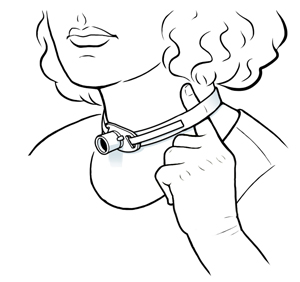Tracheostomy Care
You need to take care of your trach tube, your stoma, and the skin around the stoma. You will be told by your healthcare team how to do this. Check that you have been given a home care instruction manual for tracheostomy before discharge. Make sure you have contact information for an equipment supply company and a checklist of emergency supplies before discharge. The guidelines below may also help you.
Keeping the tracheostomy clean
To take care of your skin and prevent infection, you need to keep your tracheostomy clean. You will be shown how to do this. Clean the tracheostomy at least once a day. Clean more often, if you need to.
Keeping your trach ties or soft collar clean
Trach ties fit around your neck to hold your tube in place. They will get soiled. Fabric ties need to be changed when they are soiled. You will be shown the best way to change your ties.
If you were told to use a Velcro or soft collar, follow the instructions that were given to you by your healthcare team.
 |
| Trach ties fit right if you can put one finger between the ties and your neck. |
Keeping the trach tube clear
There is always some mucus in your airway. But mucus can build up and thicken. If this happens, your trach tube can become plugged. To keep the trach tube clear of mucus buildup, you may need to do 1 or more of the following:
-
Suction the mucus out of the airway. To do this, you use a suction machine, which will be ordered for you before you leave the hospital. You will be told how to suction and how often.
-
Moisten the air you breathe. Normally, the nose moistens air as it is breathed in. With a tracheostomy, you need another way to moisten the air, such as using a humidifier. Ask your healthcare provider what method of moistening the air you should use.
-
Do not wear clothing that blocks the opening of the trach tube. Examples can include turtleneck shirts and tightly wrapped scarves. A loose-fitting scarf that does not shed lint, have loose fibers, or block air flow can be used to hide the trach tube from sight. Or it can protect the tube from cold air and dust. Medical supply stores may sell trach coverings, as well as shields for use in the shower.
You will be told ahead of time what to do if your trach tube becomes plugged. If you ever have trouble breathing, call 911 right away.
When to call your healthcare provider
Call your healthcare provider right away if you have any of these problems:
-
Red or painful stoma
-
Small amount of bleeding from the stoma or tube that stops promptly
-
Fever of 100.4°F ( 38°C) or higher, or as advised by your provider
-
Yellow, bad-smelling, bloody, or thick mucus
-
Vomiting that does not go away
Call 911
Call 911 right away if any of these occur:
-
Large amount of bleeding, or lasting bleeding, from the tracheostomy site
-
Coughing up blood
-
Swelling around the trach tube
-
New, or worsening, trouble breathing